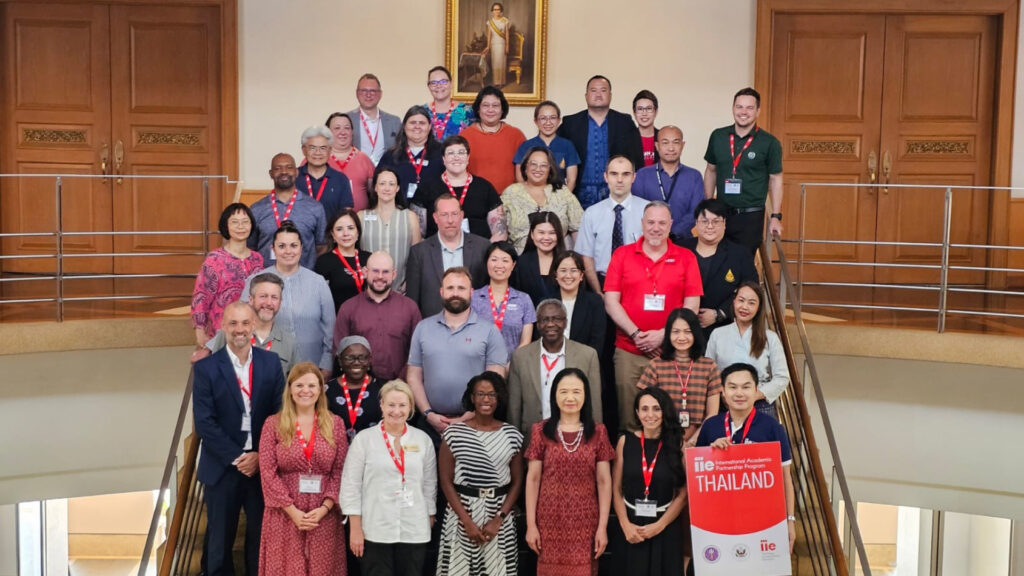As the curtain closes on the study tour portion of the International Academic Partnership Program (IAPP) journey to Thailand, participants return home not just with memories of a vibrant country but with a newfound perspective on international collaboration and the transformative power of educational partnerships. The recent captivating study tour — just one element of the IAPP Thailand — has served as a catalyst for deepening ties between U.S. and Thai institutions of higher education.
At the heart of the IAPP experience, led by IIE and the U.S. Embassy in Bangkok in partnership with the Thai Ministry of Higher Education, Science, Research, and Innovation, lies the commitment to developing meaningful partnerships that extend beyond borders. During the immersive tour in Thailand, a U.S. delegation of 18 universities and colleges delved into the intricacies of the Thai higher education system and explored opportunities for partnership and collaboration. From engaging discussions with key decision makers to visits with higher education institutions and educational exchange organizations, the study tour provided a firsthand glimpse into the rich tapestry of Thai academia.
As participants reflect on their journey with IAPP Thailand, certain themes emerge as hallmarks of the experience. Collaboration, for one, emerges as a driving force behind the program, with participants recognizing the value of working together to achieve common goals. Whether through strategic planning sessions or networking opportunities during the study tour, collaboration serves as the bedrock upon which partnerships are built.
Moreover, the program fostered a spirit of curiosity and openness to new perspectives. Participants were encouraged to step outside their comfort zones, engage with unfamiliar ideas, and embrace the diversity of thought that comes with international collaboration. In doing so, they gained a deeper appreciation for the interconnectedness of the global higher education landscape.
Perhaps most importantly, the IAPP Thailand program underscored the importance of building bridges—both figuratively and literally. In an increasingly interconnected world, the ability to forge meaningful connections across cultures and continents is more critical than ever. Through initiatives like IAPP Thailand, participants are not just building partnerships; they are building bridges that span oceans, cultures, and generations.
In addition to our university partners, IIE itself has a long, 62-year history in Thailand. Over the years, Thai universities and IIE have supported numerous refugee students and young people who have been displaced from other countries in the region. We continue this work up to today and are grateful to the many Thai universities that partner with us.
As participants return to their respective institutions, they carry with them not just memories of a transformative journey, but a renewed sense of purpose and possibility. Armed with the knowledge and experiences gained through the IAPP Thailand program, they are poised to continue building bridges, fostering collaboration, and shaping the future of international higher education.
In the end, the true measure of the IAPP Thailand program lies not just in the partnerships formed or the strategies developed but in the relationships forged and the impact felt far beyond the confines of a conference room or a university campus. It is a testament to the power of education to transcend boundaries and transform lives—one partnership, one bridge at a time.
As we reflect on the journey with IAPP Thailand, let us spell out the essence of partnerships in international education:
P – Persistence: Partnerships require dedication and perseverance to overcome challenges and achieve shared goals.
A – Access: Partnerships open doors to new opportunities, expanding access to education and resources.
R – Respect: Partnerships thrive on mutual respect, honoring diverse perspectives and cultural differences.
T – Trust: Partnerships are built on trust and transparency, fostering meaningful relationships and collaborations.
N – Networking: Partnerships facilitate connections, creating networks that span continents and disciplines.
E – Empowerment: Partnerships involve promoting inclusivity, equity, and agency, ensuring that all stakeholders have a voice and are empowered to contribute meaningfully to the partnership’s goals and objectives.
R – Reciprocity: Partnerships embrace reciprocity, recognizing the mutual benefits of collaboration and exchange.
S – Sustainability: Partnerships promote sustainability, striving for long-term impact and growth.
H – Harmony: Partnerships seek harmony, fostering positive relationships and constructive dialogue.
I – Innovation: Partnerships encourage innovation, driving forward-thinking solutions and approaches.
P – Progress: Partnerships fuel progress, advancing education and society through collective effort.
S – Solidarity: Partnerships stand in solidarity, uniting diverse stakeholders in pursuit of common goals.
The study tour has concluded, but the journey continues. As participants regroup and identify the next steps, the IIE Center for International Partnerships stands ready to provide consultations on MOUs and MOAs, assessments, and expansion models. Let’s continue to engage and build sustainable partnerships for the future.
